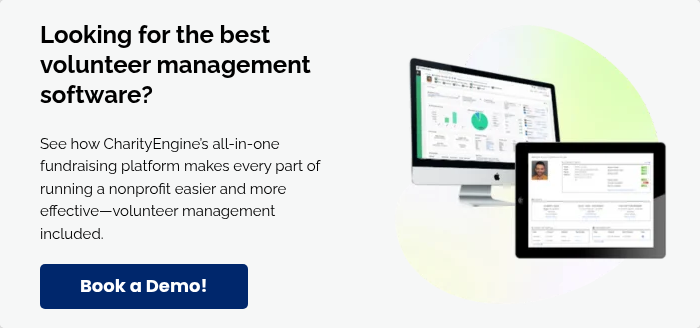.png)
It won’t surprise you that fully one-third of the nonprofit workforce is volunteers. Successful nonprofits know that they need an army of supporters to keep the lights on and the mission humming.
But let’s cut to the chase. Finding volunteers is hard, and keeping them is even harder. What are some tried-and-true strategies for creating, launching, and running a robust volunteer team?
I’ve worked in nonprofit management and even received my master’s degree in it, so I have both academic and practical experience running nonprofits. I can tell you that a core cadre of volunteers is truly the secret weapon your nonprofit needs.

In this article, I’ll share the tips and tricks I found to be most effective when managing volunteers. If you have any questions or want to chat, please reach out! I’d love to talk.
How to Tailor Your Volunteer Management Strategies
“One size fits all” isn’t a strategy! This approach to volunteer management will hinder organizational growth. Rather, it’s critical that each nonprofit tailors all management strategies to its unique needs.
Acknowledge the differences between paid staff and volunteers and recognize that volunteers aren’t motivated by a paycheck from your organization. This makes them more valuable than paid staff because volunteer satisfaction stems from how they experience your organization as volunteers, not as employees. This satisfaction evolves and strengthens over time, highlighting the need for flexible, customized administration models that align with your mission and goals.
Understand Why Volunteers Engage
Strong volunteer management means you understand what motivates your volunteers. Why might they engage? Common reasons include a personal connection to your mission, spare time, such as in the case of a retiree, career advancement, in the case of someone who needs to improve a resume for school or a job, or sometimes even just making friends and getting involved. They might be trying to find happiness or an increased feeling of self-worth, or hoping to practice existing skills or learn new ones.
Segment your volunteers according to their motivations, and then structure their engagement (and your management) to ensure they’re getting whatever keeps them motivated. A good volunteer manager will know how to tailor an experience so the work is mutually beneficial and when a volunteer might not be the right fit for your nonprofit.

5 Key Elements in Developing a Volunteer Program
Common human resources management practices—like planning, recruitment, retention, and performance assurance—are an excellent guide for volunteer management.
There are five key elements in developing a successful volunteer program.
Role Identification
Where can your nonprofit most use the help that volunteers can provide? Think beyond staffing an event, though that’s important. Is there an expertise you need, like IT or legal, that could be met through a volunteer? Is your board paid, or should you recruit members? Consider the identity and quantity of the roles you need to be filled.
Placement
Placing a people person in a warehouse stocking shelves with food items isn’t going to lead to a happy volunteer. Instead, have that person greet the public at your food pantry. In each case, align someone’s strengths with a task.
Training
Most successful volunteer programs include a consistent, documented training plan. Take the time to create a comprehensive onboarding schedule, with a general section and then sections specific to each job. Effectively training volunteers saves you time, makes them more effective, and creates a more positive volunteer experience.
Supervision
Regularly check on your volunteers. This is, of course, to see if they have questions and make sure they’re meeting your expectations. But it will also draw them in when they feel noticed and cared about. Solicit their feedback and engage them about their experience.
Evaluation
Speaking of feedback, the quickest way for your volunteer program to improve is to talk to the people in the trenches and ask what they think of your process. And when a volunteer leaves, because the event is over or they’re moving on, have a standard, quick survey to get more information.
Ensuring Volunteer Satisfaction and Retention
Making sure volunteers feel included and valued directly impacts their commitment and productivity. If they feel excluded, they can quickly become unmotivated. Further, if they’re missing training or supplies, they’ll feel frustrated and likely leave.
Introduce your volunteers to your staff and share details about your mission, vision, and values. Share clear policies and procedures. Say thank you often—from an email to a pizza lunch, let them know they’re appreciated.
Ensure your volunteers are trained and prepared for their tasks. When I was in college, I volunteered for an organization that put me in a memory loss facility. I was unprepared, and it was chaotic and overwhelming. Knowing what I know now, it could have been dangerous for me, the patients, and even the organization. Proper training can safeguard your organization against risk and help you uphold your commitment to providing safe and effective services.
A tip: Don’t accept or recruit volunteers you don’t need or can’t support. One well-trained volunteer is more effective than five trying hard but just adding work to your plate.
The Volunteer Stewardship Framework
In graduate school, I learned about the Volunteer Stewardship Framework. While this framework is similar to a traditional volunteer management framework, it strongly emphasizes fostering a sense of ownership, responsibility, and investment among volunteers. It also emphasizes the importance of developing a meaningful relationship with your volunteers, similar to how you would with financial donors.
This widely accepted blueprint recommends focusing on the following key areas:
- Recruitment and Onboarding
- Training and Development
- Recognition and Appreciation
- Communication and Engagement
- Performance Evaluation
- Retention Strategies
As you develop or enhance your program, making sure each of those boxes is checked with processes can help ensure its success.
Volunteer Management Will Unleash People Power!
Understanding the importance of volunteers, tailoring your strategies, understanding what makes volunteers tick and where they’ll be the most effective, and following a trusted framework are the building blocks to success.

When you build or rebuild a strong volunteer program, you’ll find it almost self-sustaining…people tell their friends, and more volunteers pop up. And often, your committed volunteers become committed donors, so your work can amplify results across the board.
I’d love to hear about your volunteer program and see if there’s anything at CharityEngine that can help. Don’t hesitate to reach out to me!





.png)
